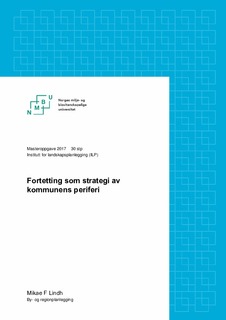| dc.contributor.advisor | Røsnes, August Edvard | |
| dc.contributor.author | Lindh, Mikael Fredrik | |
| dc.coverage.spatial | Norway, Tønsberg | nb_NO |
| dc.date.accessioned | 2017-11-09T12:32:44Z | |
| dc.date.available | 2017-11-09T12:32:44Z | |
| dc.date.issued | 2017 | |
| dc.identifier.uri | http://hdl.handle.net/11250/2465245 | |
| dc.description.abstract | Dagens byplanlegging er en krevende praksis. Befolkningsvekst, som en følge av fødselsoverskudd og innvandring, samtidig med en kontinuerlig urbaniseringsprosess, fører til et stort befolkningspress i de største byene. Samtidig som byene vokser i innbyggertall ønsker offentlige myndigheter å begrense veksten av byggesonen, og heller konsentrere de nye innbyggerne innenfor dagens tettstedsgrenser, for å minske de negative konsekvensene av et utflytende utbyggingsmønster. Fortetting har derfor blitt et sentralt politisk virkemiddel for å oppnå en mer effektiv og bærekraftig arealbruk.
I denne oppgaven har jeg brukt Tønsberg som case for å se på hvordan byen kan benytte fortetting som strategi også utenfor dens mest sentrale områder, for å oppnå at den ønskede andelen av nye boliger skjer som fortetting, der kommunens målsetning om andelen av fortetting/transformasjon som skal skje innenfor byområdet kan synes vanskelig å oppnå, grunnet blant annet planlagte infrastrukturprosjekter. Oppgaven tar til orde for at desentraliserte konsentrasjoner i kommunens forsteder kan supplere fortetting i sentrum for å oppnå det ønskede målet for fortetting, bygget på den eksisterende senterstrukturen, og utnytte det potensialet som ligger i disse sentrene. Utfordringen med en slik strategi ligger i behovet for en tetthet som kan fremme gang, sykkel og miljøvennlige transportformer samtidig som behovet for økt tettheter må forenes med folks boligpreferanser for at folk skal ønske å bosette seg i slike tett utbygde lokalsentre.
Strategien bruker Vear som et eksempel på hvordan lokalsentrene kan utvikles til bærekraftige timinuttersbyer, som sammen med solide kollektivforbindelser til sentrum kan utvikle Tønsberg til en bærekraftig «timinuttersstjerne». | nb_NO |
| dc.description.abstract | The city planning of today is a demanding practice. A rise in population, as a result of higher birth rates and immigration, along with a continuous urbanization process, leads to a high population pressure in the largest cities. At the same time as the cities grow in population numbers, the public authorities wish to limit the growth within the building zone, and rather concentrate new residents within today’s urban city limits, to limit the negative consequences caused by a scattered development pattern. This has caused densification to become a key political instrument to achieve a more efficient and sustainable land use.
In this assignment I have used Tønsberg as a case study to look at how the city could also utilize densification as a strategy outside the city’s most central areas, to make sure the desired amount of new housing is achieved through densification, where the municipality’s set goal of the amount of densification/transformation that is desired within the metropolitan area might seem difficult to achieve, partly because of planned infrastructure projects.
The assignment advocates that the decentralized concentrations in the municipality’s suburbs might supply densification at the city center to achieve the wanted densification goal, built on the existing center structure, and hence utilize the potential that exist at these centers. The challenge of such a strategy lays in the need for a density that can promote walking, cycling and environmentally friendly forms of transportation at the same time as the need for increased densities has to be united with peoples housing preferences to make sure people will want to settle down in these kinds of densely developed local city centers.
The strategy uses Vear as an example of how the local city centers can be developed into sustainable ten minute-cities, which along with solid public transportation connections to the city center could transform Tønsberg into a sustainable «ten minutes-star». | nb_NO |
| dc.language.iso | nob | nb_NO |
| dc.publisher | Norwegian University of Life Sciences, Ås | nb_NO |
| dc.rights | Attribution-NonCommercial-NoDerivatives 4.0 Internasjonal | * |
| dc.rights.uri | http://creativecommons.org/licenses/by-nc-nd/4.0/deed.no | * |
| dc.subject | Fortetting | nb_NO |
| dc.title | Fortetting som strategi av kommunens periferi | nb_NO |
| dc.type | Master thesis | nb_NO |
| dc.description.version | submittedVersion | nb_NO |
| dc.description.localcode | M-BYREG | nb_NO |

